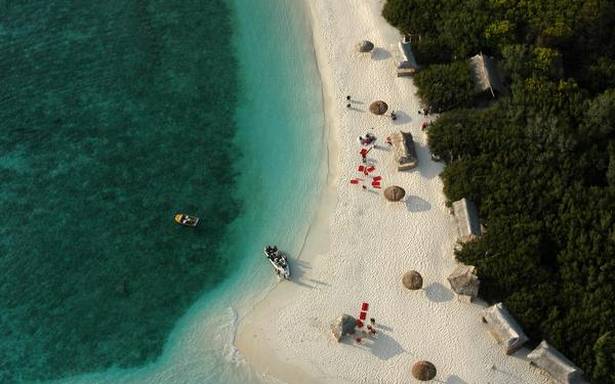Hidden in the azure waters of Lakshadweep’s lagoons is a stunningly colourful world: corals burst in tones of red, pink, yellow and blue. “And you’ll find every colour of the rainbow in the reef fish,” says Nachiket Kelkar, a biologist who has studied these lagoons. These waters are also home to a variety of threatened and endangered marine life, including green turtles, sea cucumbers, giant clams and corals.
Closer to the shore, and beneath the seemingly barren white sand, grows an entire grassland. Tiny tips of smooth, waxy sea grass gently break the grainy surface, and if left undisturbed, will grow into a lush meadow in a few years, waving their green fronds as far as the eye can see.
But all these inshore reefs and underwater grasslands may be in deep peril if an ambitious tourism project — involving the construction of beach and water villas offering 370 rooms — becomes a reality.
The multi-crore project has been proposed by NITI Aayog and the Ministry of Home Affairs. In a petition this January, 114 scientists from more than 30 universities and research institutes urged the Lakshadweep administration to reconsider the project, fearing the possible ecological impact it could have on the islands’ sensitive lagoons and beaches.
News about tourism villas on 10 islands in the Andaman-Nicobar and Lakshadweep archipelagos has been trickling in since October 2018. A 2019 NITI Aayog report lists ‘best possible development strategies’ for the ‘holistic’ development of these islands. In the 36-island archipelago of the Lakshadweep, this proposal has been earmarked for the islands of Kadmat, Minicoy and Suheli.

Boulder-like Porite coral near the island of Kadma
| Photo Credit:
Rohan Arthur
With an initial investment of ₹266 crore (and additional investments of up to ₹788 crore expected from the private sector), the project will be implemented by Lakshadweep’s Society for Promotion of Nature Tourism and Sports (SPORTS).
Just like Maldives
The NITI Aayog report repeatedly stresses that the projects are ‘technically feasible, economically profitable and socially acceptable’; that the ‘up-front’ clearances (both environmental and Coastal Regulation Zone) recommended for the project are a ‘unique move aimed at creating much-needed conducive environment for private entrepreneurs to invest’. And in November last year, the Lakshadweep administration supplied more details of the project to potential bidders: successful bidders would get 75 years to finance, construct and operate the projects. Floating solar panels in the lagoons nearby will supply sustainable energy. And as much as 75% of the jobs will go to the local community, says Asker Ali, Managing Director of SPORTS.
Not so win-win
The vision appears straightforward and grand: create job opportunities for locals, and world-class, ‘Maldives-like’, carbon-neutral tourism facilities that will also give India its first-ever water villas. A win-win for all stakeholders: the government, locals and tourists. But the ecological impact of such a project on the lagoons and coral reefs is likely to be far more complex and damaging than what is being acknowledged, argue India’s scientists in their petition.
Rohan Arthur is a marine biologist with the Nature Conservation Foundation-India and has been studying Lakshadweep’s ree

